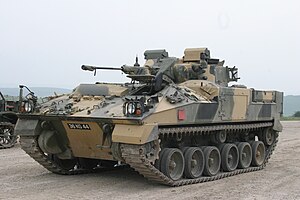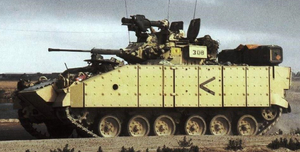Claymore Infantry Fighting Vehicle
| Claymore Infantry Fighting Vehicle | |
|---|---|
 Claymore IFV of D Company, 2nd Battalion, Fulham Grenadiers | |
| Place of origin | |
| Service history | |
| In service | 1986-present |
| Used by | Commonwealth Army |
| Production history | |
| Designed | 1980-1984 |
| Manufacturer | Arthuristan Dynamics |
| Produced | 1985-present |
| Specifications | |
| Weight | 18-35 tonnes |
| Length | 7m (hull) |
| Width | 3.1 m |
| Height | 2.5 m |
| Crew | 3 (gunner, driver and commander, who doubles as section leader and dismounts with the infantry) |
| Passengers | 7 |
| Armor | Integral: welded steel armour Applique: light ceramic-composite aromur |
Main armament | 30mm RARDEN autocannon (Mark 1), 30mm Mk44 autocannon (Mark 2) |
Secondary armament | L6V machine gun co-ax, Sharpshooter Remote Weapon Systemmachine gun and 2x Vesper missiles |
| Engine | Apollo Motors AVE-4 V-8 diesel 531 kW, 720 bhp |
| Transmission | Hydropneumatic |
Operational range | 600km on roads |
| Speed | 75 kph on roads |
The Claymore IFV is a model of infantry fighting vehicle in Arthuristan service, introduced in the mid-80s into the Commonwealth Army.
Unlike in many CDI armies, the introduction of the Claymore did not lead to a wholesale replacement of older APCs. Rather, vehicles of the FV430 series were given new powerpacks and armour and continue to serve in support roles, mostly due to their lower cost, as well as their greater capacity in carrying dismounts and cargo.
Armaments

The Claymore's weapons suite is mounted on its two-men turret. The original Mark 1 model had a 30mm RARDEN autocannon. The post-2007 Mark 2 upgrade features an improved 30mm chain-fed cannon, capable of firing depleted uranium APDS-T, smart airburst, canister, HESH and thermobaric rounds. A [[L6V machine gun is mounted as a co-axial weapon for targets which do not require the heavy firepower of the autocannon.
Early Claymore rifle section carriers were fitted with a pintle-mounted Vanguard missile firing post at the commander's hatch. This may be detached and used by the infantry section carried within the vehicle when dismounted. When the section is mounted and the vehicle buttoned-up, the missile may be launched under-armour by the commander using his panoramic thermal sight, although it must be manually reloaded once it has been fired. This setup has been replaced by the Sharpshooter Remote Weapon System. Aside from a machine gun, the RWS is attached with two Vesper anti-tank missiles, which may be fired when the vehicle is buttoned and on the move. A Command-Launch Unit ('CLU') is carried in the cabin, allowing the infantry element to detach a missile from the RWS and carry it with them for dismounted use.
Protection
Armour
At its most basic configuration, the Claymore's welded steel armour can withstand 14.5mm AP heavy machine gun rounds from the frontal arc. First-line units typically receive the AMAP upgrade, rendering it resistant against 30mm APDS fire from the frontal arc, 14.5mm AP rounds from all angles and light shaped charge warheads such as DPICM and other anti-armour bomblet munitions from above. In second line or reserve units, slat-armour may be fitted to protect the vehicle from common handheld AT weapons. They are typically hardened against mines and IEDs with the installation of a blast-deflecting floor plate.
Active Defence Systems
From 2009, many Claymores in first-line units have been retrofitted with the Redoubt Automatic Countermeasure System, an integrated suite combining automatic hardkill and softkill countermeasures with a variety of sensors. Its sensors component consists of apertures and receivers placed on a variety of spots on the vehicle's upper superstructure and covers the entire upper hemisphere. It includes electro-optical and radar targeting warning systems derived from similar technology developed by Arthuristan Dynamics Supermarine for the Tempest fighter and a millimetre-band miniature radar array capable of detecting incoming missile or RPG rounds. The softkill component uses automatic decoy and smoke dischargers effective against all relevant electro-magnetic wavelengths (derived from the MASS decoy system in use in the Commonwealth Navy, making it effective against thermal-imaging systems. It also incorporates DICM and laser dazzler-blinders to directly attack and disable targeting devices once they are detected.
The hardkill component uses a pod of eight vertical-launched missiles mounted on the rear of the turret to intercept incoming threats, a lightened and miniaturised version of the variant employed on the Boudicca Main Battle Tank. The missiles are shaped like small mortar bombs equipped with a proximity sensor, with a shell made of a fully-combustible material, designed to neutralise incoming ordnance with blast pressure alone. It is thus cheaper than 'hit-to-kill' solutions, as it does not rely on complex interception-generating systems, while at the same time unlikely to generate as much collateral damage to the surroundings compared to fragmentation-based setups, an overall design which the Ministry of Defence feels offers the best compromise.
Signature reduction
The latest upgrade package equips the tanks with active thermal panels to achieve some degree of IR stealth. Radar-absorbent coating helps to lower the tanks' signature and help to avoid detection, while counter-laser bloomers have been installed to destroy laser range-finding gear targeting the vehicle.
Mobility
The vehicle's V-8 diesel engine allows for an excellent power to weight ratio. Top speed is 75km/h on roads, although this is artificially limited by a governor and the vehicle has been tested to 85 km/h.
In terms of strategic mobility, the Claymore is too large for transportation by the ubiquitous C-130 Hercules. However, the new Airbus A-400M Atlas tactical airlifter, almost twice as large as the legacy platform, can transport up to two Claymores in their lightest armour configuration. Strategic airlifters such as Globemaster IIIs, C-5 Galaxies and Antonov AN-124s can typically transport between three to six.
The platform is theoretically amphibious. However, it is only able to float with the lightest armour configuration and thus this capability was hardly ever utilised in practice.
Networking
Claymores are "networked platforms". They are equipped with the Arthuristan Dynamics Digital Battlefield Management System which integrate vehicles in one or multiple units into the combat network (the ARES Battlenet in the Arthuristan Army), allowing them to communicate efficiently and share valuable intelligence, whether with other tanks and vehicles, UAVs, CAF aircrafts providing CAS, or any other platforms or 'information nodes' of the Arthuristan military. Such tactical data are displayed on the commander's tablet computer, which can be mounted in a bracket at his/her station. Enemy sightings, targeting information and other intelligence gathered by the tank's sensors are also automatically transmitted across the ARES battlenet and thus made available to all other platforms linked to it.
Other major variants
Claymore Armoured Mortar Vehicle
The Claymore AMV is equipped with the Hatchet Recoil Mortar System. It replaced the FV430 and 81mm mortar combination in 1990's.
Claymore Forward Observation Vehicle
Intended for the direction of joint fires, the FOV is based on the ACV platform, but fitted with a MSTAR battlefield surveillance radar system and an increased payload of communications equipment. There is no longer any space for dismounts and the main gun has been replaced with a dummy substitute.
Claymore CRBN Reconaissance Vehicle
This variant is essentially similar to the cavalry vehicle, albeit with a sensors package optimised for detecting atmospheric contaminants.
Claymore Electronic Warfare Vehicle
The EWV is equipped with antennae, signals analyser and other desiderata of modern electronic warfare tasked with data collection, locating enemy forces, especially those of headquarters, intercepting and jamming enemy communications and conducting electronic attacks when operating in the FEBA. The EWV Upgrade Program of 2008 adds a directional SATNAV jammer as a countermeasure against UAVs.
Claymore Drone Carrier Vehicle
The DCV is a special flatbed variant of the basic Claymore chassis, configured to carry and launch the Lancelot Medium Loitering Drone.
Claymore Casualties Evacuation Vehicle
The CEV is used to provide a rapid protected casualties evacuation capability.
Claymore Armoured Recovery Vehicle
This variant can recover any vehicle of the Claymore family.